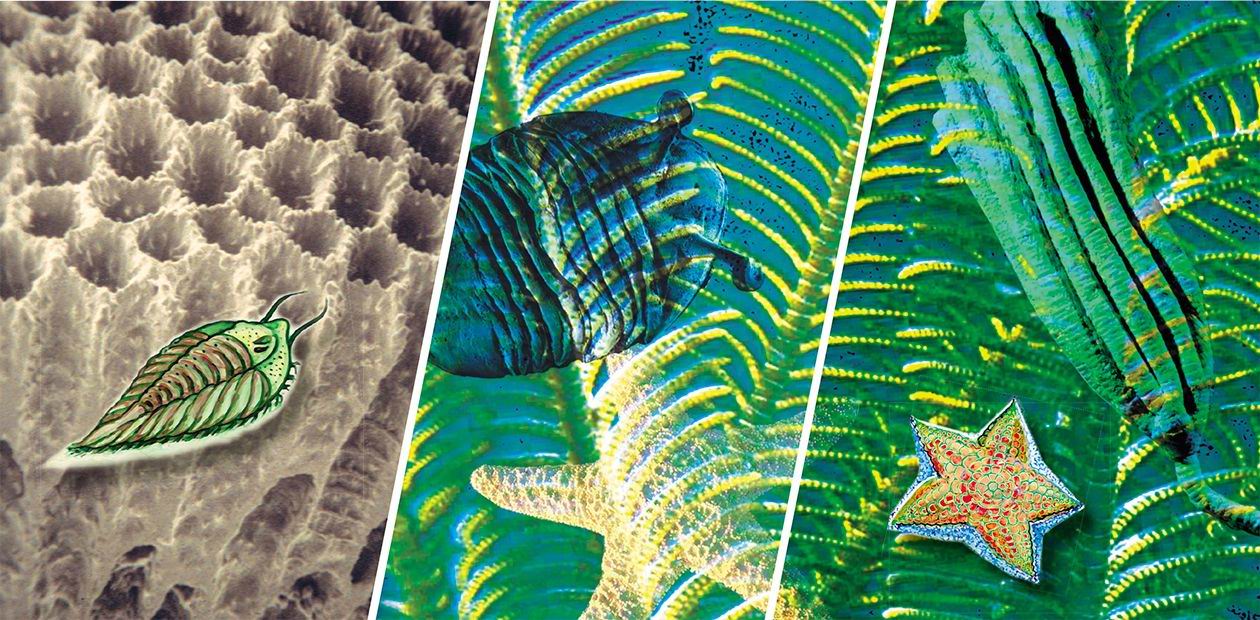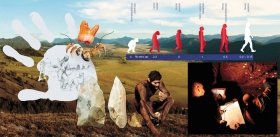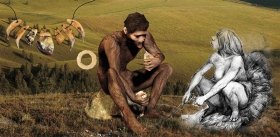In Praise of Catastrophes
Rocks that formed in place of ancient seas and continents, the stone pages of the Earth’s history, store a unique natural record of its remote and near past. This archive keeps signature of the billion years-long way of the Earth’s organic world from primeval microbial communities to humans, the evolution acme. The life evolution was marked by many geologic cataclysms which caused dramatic changes to environment. The geologic shocks suffered by ecosystems were actually large-scale natural experiments unfeasible for a laboratory. The fragmentary but readable records of these events provide clues to many enigmas of life, including the creative role of geologic catastrophes in the formation of the biosphere
The Evolution Theory: A Child of Biology and Paleontology
The 19th century gave birth to the evolution theory which later became the ideological foundation of natural sciences. Early evolutionists developed their ideas of gradual development on different grounds. Jean-Baptiste Lamarck took a biological approach and viewed evolution in terms of biologic diversity. Charles Lyell, a geologist, addressed geological changes of the Earth as the substrate of life. Charles Darwin, the most famous evolutionist, brought together biological knowledge on the diversity of the existing species and paleontological evidence for speciation in the geologic past. This pioneering interdisciplinary approach ensured the triumph of Darwin’s theory.
The fundamentals of Darwin’s theory concerning speciation controls (heredity, variability, and selection) remain basic in the modern evolution theory but the mechanisms of this trinity have been a subject of discussions from the beginning. Darwin was accused of overestimating the environment and underestimating the self-development of species by intrinsic biologic mechanisms. The latter were however unknown to Darwin and were discovered later by Gregor Mendel as the laws of heredity and recombination of characters.
Eventually biologists and paleontologists took different ways in studying the internal and external factors of evolution: the former focused on internal life mechanisms and the latter on environment. This discord remains unbridged so far. Moreover, the knowledge breakthrough of the 20th century yielded many brilliant scientific discoveries but split the stream of natural sciences into many armlets difficult to bring together. Bridging the gap requires a new union of biology and geology and joint efforts of experts from various fields of learning.
Main post-Darwinian discoveries are associated with the insight into the living microcosm. The evolution theory was gradually engrossed by new branches of biology: cytology, genetics, molecular biology, and biochemistry. We learned how internal biologic processes drive the microevolution, i.e., directed changes of organisms at the level of species and subspecies.
Yet microevolution is just the first step in the life history. The main results of these changes appear in the geologic time as a series of new superspecies groups (taxa): genera, families, and phyla. The present life diversity would be impossible without this macroevolution. These are the abrupt qualitative leaps that make evolution irreversible and progressive, whereas microevolution is basically reversible.
The very terms micro- and macroevolution were coined as early as in 1927 by Filipchenko, a known Russian geneticist. However, the understanding that life evolution has been governed by geology came only after we had read many pages of the paleontological chronicle. Geologic factors control the geochemical base of life as a matrix of life space, the development trends for the living forms, and the periodicity of changes of the biosphere as a whole. The Earth’s global ecosystem, the top of the life hierarchy, sets up the evolution corridor where specific communities are subject to final tuning.
The relation between geologic and biologic processes is especially prominent in global catastrophes. This fact was first noted by Georges Cuvier, famous French paleontologist and geologist, the initiator of comparative anatomy. However, his concept of catastrophism was rejected by victorious evolutionists. Moreover, it was branded as a reactionary theory, allegedly proving multiple acts of the divine creation after each catastrophe (though Cuvier himself had nothing to do with this idea). Nowadays, geology furnishes evidence that rehabilitates Cuvier without rejecting Darwin.
Face to face a face is unseen....
It often happened that ideas refused one day became brought to life later at further stages of knowledge and the originally antagonistic views became reconciled. Even in the exact science such as physics, the quantum and wave theories of space which seemed absolutely conflicting turned out to just describe different faces of the physical world.
Cuvier revealed the geological traces of global catastrophes alternated with dramatic renovations of the biosphere, whereas Darwin found evidence for continuous gradual development of speciesDarwin is still believed to have done away with Cuvier’s catastrophism, but both were right! They actually saw different levels of the intricate hierarchy in the history of life.
What Darwin considered is the microevolution in which a species is a brick in the self-assembly of supraspecies taxa influenced by environment. Cuvier, his predecessor, who dealt with much scantier evidence of fossils, came to see the major changes, or the macroevolution of the organic world. This is the way one sees impressionists’ painting: only at a distance the picture emerges out of scattered brushstrokes.
Evolution should now be considered rather as changing interaction of elements in large systems than as a sequence of morphological entities irrespective of their function in ecosystems. This new approach is known as ‘universal evolutionism’, a term coined by academician N. Moiseev, mathematician. According to the theory of large systems, the biosphere has evolved in close relationship with its geological substrate and passed through critical points of imbalance between the geologic environment and biota. Thus geologic cataclysms pushed forward the biospheric evolution, — this is the alibi for Cuvier!
Geo and Bio Hand in Hand
The general trend in biospheric evolution is determined by the descending cause-and-effect chain in contrast to Darwin’s idea of self-assembly from bottom to top. The reason is that geologic processes control the geochemical base of life: a system of coordinated biogeochemical cycles of over forty chemical elements. These processes involve not only the outer Earth’s rinds (lithosphere, hydrosphere, and atmosphere) but also the sublithospheric space wherefrom life elements come to the surface.
The population of continents is actually the evolution product of the marine ecosystem. For over three billion years, this giant biogeochemical machine supplied oxygen to the atmosphere, so that animals could breathe and the whole land life be protected from the attack of ultraviolet radiationThe key role in the operation of the global ecosystem belongs to oxygen and carbon dioxide, two atmosphere-forming gases, and their balance governs photosynthesis and respiration, two basic processes in the living world. In photosynthesis, carbohydrates are derived in the light from carbon dioxide and water, i.e., the solar energy is conserved by conversion into the chemical energy in organic compounds; molecular oxygen is released as a by-product. Respiration is the antithesis of photosynthesis and implies oxidizing ready-made organic compounds to produce energy used by the organism.
The evolution of autotrophic (capable of utilizing carbon dioxide) and heterotrophic (consuming only ready organic substances) organisms shows that the former developed ahead of the latter at all critical stages. For instance, the appearance of new vegetation forms always preceded the animal evolution, because carbon dioxide comes from the Earth’s interior with volcanic eruptions while oxygen and organic nutrients are of secondary biogenic origin.
The primeval Earth’s atmosphere and hydrosphere were anoxic. Little by little, photosynthesizers generated free oxygen, and further life evolution was determined by gradual or leap-like oxygenation of water and air. Intermittent pulses of volcanism, especially in the time of major geodynamic events (collisions or breakup of continents, opening or closure of oceans, etc.), released carbon dioxide to the atmosphere and triggered the development of photoautotrophs. Originally, these were water-living cyanobacteria and algae. Later, vegetation began the conquest of land when the atmosphere accumulated enough oxygen to form the ozone shield. Flora was followed by fauna.
Proofs can be found nearly half a billion years back in the geologic record, in the Ordovician. This geologic period (500—435 million years ago) first appeared ordinary unlike, say, the Jurassic, marked by the acme and subsequent extinction of giant reptiles. However, the Ordovician turned out to have witnessed a unique series of coeval biotic and geologic events combined to guide the course of the whole biosphere.
Biodiversity Outbreak
One of the five greatest extinctions in the latest Ordovician was paradoxically the first discovery related to that period. Leaving aside its causes, what is important is that the extinction was preceded by the largest-scale jump of biodiversity when it tripled within an extremely short time. (For a long time this fact remained masked by the importance of the extinction, as forest can be missed behind trees.)
What was the scene of these dramatic events? Land was lifeless at that time because the atmosphere was too poor in oxygen (about 10—20 % of the present-day concentration) to develop the ozone layer. Oceanic depths were neither inhabited for oxygen deficit because of poor water mixing. Such dead zones exist in modern seas as well, e.g., on the bottom of the Black Sea.
Life settled in the most favorable environments of shallow seas, at least, at the beginning of the evolution, due to hot springs, illuminated water depths (conditio sine qua non for photosynthesis), river supply of abundant solid and dissolved nutrients, and water mixing facilitating oxygenation and distribution of nutrients. These conditions still make shallow shelf seas the most productive areas of the biosphere.
These were the conditions in which the taxonomic outbreak occurred in the Ordovician. The Ordovician fauna peak was discovered unexpectedly when modeling biodiversity time curves of marine organisms. J. Sepkoski, American paleontologist, noted that the structure of the marine ecosystem similar to the modern one had formed in the Ordovician rather than in the Cambrian (about 540–520 million years ago) as it was commonly believed.
What was the cause of this dramatic biodiversity jump? I found the answer in a paleo-environmental analysis of the Ordovician biota.
Beginning of Globalization
Note first of all that the Ordovician was the time of the most intense volcanism for the past 500 myr which released enormous amounts of carbon dioxide to the atmosphere to support the life of algae. Phytoplankton (microscopic algae) appeared as early as in the Precambrian but became ubiquitous inhabitants of water iт the Ordovician. The development of phytoplankton was accompanied by a dramatic shrinking of cyanobacterial ‘meadows’, the former main source of food for bottom animals. Thus the autotrophic base shifted from the sea bottom up toward the surface. This altered the entire spatial structure of the sea ecosystem, especially compacted it and produced a new food web.
An abrupt oxygen increase as a result of rapidly growing productivity of algae (autotrophs) was the following and probably the most important event which caused key changes to the heterotrophic population. Almost all Ordovician taxa were oxyphilic, or having greater demand for oxygen than their ancestors. This biologic piece of evidence is in good agreement with rapid oxygenation of the Earth’s surface known from geology.
Indeed, what should a ‘newborn’ organism do to survive? It can move elsewhere in search for a better luck, unoccupied habitats. Or, master new ways of getting food in the same biotope and find its own nicheThe fauna gratefully responded to the changes in the resource structure. New taxa made use of the elements designed in the Cambrian, namely cell and tissue differentiation, skeleton shape, devices for locomotion and nutrition, etc., whose recombination produced a broad range of new alimentary tools.
Indeed, what should a ‘newborn’ organism do to survive? It can move elsewhere in search for a better luck, unoccupied habitats. Or, master new ways of getting food in the same biotope and find its own niche. Some species can extract organic matter from mud (mud-eaters), others from suspended particles (filter-feeding organisms), third ones consume dissolved nutrients, fourth eat dead remnants of plants and animals (grazers and necrophages), and fifths are predators. This multi-link food chain started its development in the Ordovician. Since that, we observe gradual globalization of the sea ecosystem: first, at shelf bottoms; then in the water column, and, after all, at greatest depths.
The Many-sided Ordovician
Cambrian and partly Early Ordovician seas were conquered by trilobites. They got nutrients by recycling mud like modern earthworms. Cambrian mud was particularly rich in organic matter which all settled on the bottom for the lack of skilled catchers of suspended particles in the water.
In the Ordovician, there appeared filter-feeding organisms, able to feed near the bottom by catching nutritive particles immediately from water. They were corals, bryozoans, and crinoids. Brachiopods reached their acme, and numerous species of omnivorous ostracodes appeared in abundance. Nearly all these organisms proved to be evolution long-livers and survived until now. However, trilobites became extinct, though tried to adapt to new conditions in the Ordovician. Some species learned to defend themselves against predators: some became appallingly large, others buried themselves into mud and exposed their eyes as ‘periscopes’ on long stalks; many rolled into a ball, like hedgehogs. Yet in spite of all these means, trilobites failed to compete for food with more advanced consumers.
The new groups of organisms formed benthos, the bottom or near-bottom biota. The multi-level structure at the bottom had its lower level still occupied by trilobites and attached (mainly colonial) organisms above. The colonial life, like in modern coral reefs, is another efficient way of conquering the living space and getting food from water ever flowing due to coordinated movements of animals.
Gradually the pelagic zone became colonized. The first groups of specialized pelagic organisms which appeared in the Cambrian and quickly flourished were graptolites and radiolarians. First they preferred to remain attached to the bottom and quickly occupied the pelagic zone as soon as phytoplankton began to provide them enough food.
Numerous predators appeared: fast-swimming nautiloids, primitive jawless fishes, conodonts, large gigantostracans, and starfishes, and the Ordovician marine ecosystem began to acquire the modern features.
Hurrah for the Revolution — Revolution in environment!
What did the emergence of numerous trophic specializations mean for the biosphere? Before, life evolved in poor environment. The competition for resources being easy if any, the evolution strategy of communities was to adapt to the unstable abiotic (nonliving) environment. The Ordovician marked a new stage in the life history when organisms adapted to the physicochemical environment, which began to stabilize, but more so to their habitat neighbors, astute competitors for food. The most successful evolution strategy in these conditions was to implement the Black Queen’s principle. “It takes all the running you can do, to keep in the same place. If you want to get somewhere else, you must run at least twice as fast as that!” (L. Carroll).
Some such processes of specialization and globalization of the ‘ecosystem’ occur in the human society. The primitive man almost fully depended on nature and much less on the neighboring tribes. Forced to compete with the neighbors, people could set off for new hunting grounds, or to master a new skill, agriculture or husbandry. In the modern industrial society, everyone has to have a niche of his own, a job conforming to others. Conformance and compromise make an effective evolution strategy in densely populated ecosystems. These ecosystems can be called coherent. The coherent evolution started just in the Ordovician, when the biotic factor began to boost evolution.
The Ordovician events were actually a true environmental revolution and outlined the further pathway to give rise to millions of various groups of living beings on modern EarthTurning back to the Ordovician extinction, note that the living space reduced dramatically at the end of the period because of glaciation and shoaling. This is most likely responsible for extinction of many species, though all major new taxa survived the glaciation to live until now. Yet, this is of secondary importance. What is important is the irreversible change of the whole Earth’s biogeochemical system which changed the relationships of the biota components among themselves and with the abiotic environment. The Ordovician events were actually a true environmental revolution and outlined the further pathway to give rise to millions of various groups of living beings on modern Earth.
Photos of samples from the Paleontological Institute collection are published with kind permission of A. Yu. Rozanov, Director of PIN, Moscow
Figures of samples from the collection of fossils (PIN, Moscow) are reproduced from the book “Early Life: Coast of Angaride” by E. A. Yolkin
and G. M. Prashkevich














